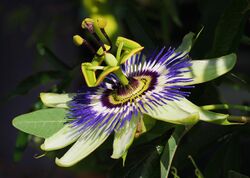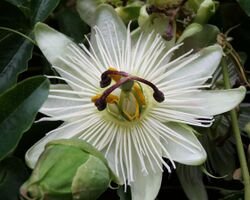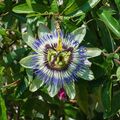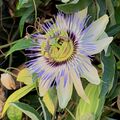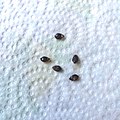Biology:Passiflora caerulea
| Passiflora caerulea | |
|---|---|
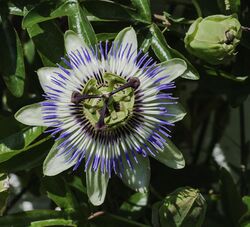
| |
| Flower in full bloom together with a wilted flower and a yet unopened bud | |
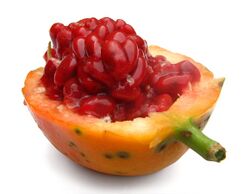
| |
| Fruit cut and opened | |
| Scientific classification | |
| Kingdom: | Plantae |
| Clade: | Tracheophytes |
| Clade: | Angiosperms |
| Clade: | Eudicots |
| Clade: | Rosids |
| Order: | Malpighiales |
| Family: | Passifloraceae |
| Genus: | Passiflora |
| Species: | P. caerulea
|
| Binomial name | |
| Passiflora caerulea | |
Passiflora caerulea, the blue passionflower,[1] bluecrown passionflower[2] or common passion flower, is a species of flowering plant native to South America. It has been introduced elsewhere. It is a vigorous, deciduous or semi-evergreen tendril vine growing to 10 m (33 ft) or more. Its leaves are palmate, and its fragrant flowers are blue-white with a prominent fringe of coronal filaments in bands of blue, white, yellow, and brown. The ovoid orange fruit, growing to 6 cm (2 in), is edible, but is variously described as having a bland,[3] undesirable,[4] or insipid taste.[5] In South America, the plant is known for its medicinal properties, and is used by both the Toba and the Maka peoples.[4][6]
Names
The specific epithet caerulea means "blue" and refers to the blue coronal filaments.[7]
Description
Passiflora caerulea is a woody vine capable of growing to 25 metres (82 ft) high where supporting trees are available.[8] The leaves are alternate, palmately five-lobed (sometimes three, seven, or nine lobes), and are up to 10 centimetres (3.9 in) in length while being linear-oblong shaped.[9] The base of each leaf has a flagellate-twining tendril 5–10 centimetres (2.0–3.9 in) long, which twines around supporting vegetation to hold the plant up.[8]
The flower is complex, about 10 centimetres (3.9 in) in diameter,[9] with the five sepals and petals similar in appearance, whitish in colour, surmounted by a corona of blue or violet filaments, then five greenish-yellow stamens and three purple stigmas.[8] The fruit is an oval orange-yellow berry, 6 centimetres (2.4 in) long by 4 centimetres (1.6 in) in diameter, containing numerous seeds.[8] It is edible to humans when ripe, but tends to have an undesirable flavour[4] unless allowed to fully ripen in a warm climate and fall naturally from the vine, when it has a mild blackberry flavour, though with a lower sugar content than commonly eaten species.
Cultivation
Passiflora caerulea is widely cultivated as a wall-climber or as groundcover. Though hardy down to −10 °C (14 °F), it requires a sheltered position facing south or west (in the Northern Hemisphere). It can become invasive, the twining shoots constantly appearing unless eradicated. It has gained the Royal Horticultural Society's Award of Garden Merit.[10]
Cultivars
A number of cultivars have been produced from the species:
- 'Chinensis' (corona filaments paler blue)
- 'Constance Elliott' was raised by Kucombe and Prince in Exeter, Great Britain. It has pure white, fragrant flowers; not as free-flowering as many other clones. It has also won the Award of Garden Merit from the Royal Horticultural Society.[11]
- 'Pierre Pomie', a pale pink flower form
Chemical constituents
Compared to Passiflora incarnata, this plant contains higher amounts of the MAO-inhibitor harmine.[12]
Uses
Though the fruit is edible, it is rather insipid when eaten raw. A tea can be made of the flower or leaves; however, tetraphyllin B and epi-tetraphyllin B, cyanogenic glycosides which liberate hydrogen cyanide when activated by enzymes, have been found in the leaves. It is possible to boil away most of the cyanide.[5]
In South America, the plant is known for its medicinal uses. It is used in both herbal tea and dietary supplements, as well as in marmalades, ice creams, syrups and beverages.[4][6] It is also used by the indigenous Argentinian Toba and Maka people.
Passiflora caerulea is sometimes used as a rootstock, to which is grafted a scion of the edible Passiflora edulis.[13]
The passion flower is the national flower of Paraguay. Its intricate structure has generated Christian symbolism, each part representing a different part of the Passion of Christ. The "Etymology and names" section of Passiflora contains more information about this symbolism.
Gallery
References
- ↑ (xls) BSBI List 2007, Botanical Society of Britain and Ireland, https://bsbi.org/download/3542/, retrieved 2014-10-17
- ↑ "Passiflora caerulea". Natural Resources Conservation Service PLANTS Database. USDA. https://plants.usda.gov/core/profile?symbol=PACA22.
- ↑ RHS A-Z encyclopedia of garden plants. United c ZKingdom: Dorling Kindersley. 2008. pp. 1136. ISBN 978-1405332 965.
- ↑ 4.0 4.1 4.2 4.3 Popay, Ian. "Passiflora caerulea (blue passionflower)". https://www.cabi.org/isc/datasheet/116172.
- ↑ 5.0 5.1 DS Seiglera, KC Spencera, WS Statlerb, EE Connb, JE Dunnb, 'Tetraphyllin B and epitetraphyillin B sulphates: Novel cyanogenic glucosides from Passiflora caerulea and P. alato-caerulea', Phytochemistry, 21/9 (1982), 2277-2285.
- ↑ 6.0 6.1 Mendiondo, G.M.; García, M.T.A. (2009). "Germination of stored and scarified seeds of Passiflora caerulea L. (Passifloraceae).". Plant Biosystems 143 (2): 369–376. doi:10.1080/11263500902722709. ISSN 1126-3504. https://www.cabi.org/isc/abstract/20093350304. Retrieved 28 August 2022.
- ↑ Harrison, Lorraine (2012). RHS Latin for gardeners. United Kingdom: Mitchell Beazley. pp. 224. ISBN 9781845337315.
- ↑ 8.0 8.1 8.2 8.3 "Factsheet - Passiflora caerulea (Blue Passionflower)". https://keys.lucidcentral.org/keys/v3/eafrinet/weeds/key/weeds/Media/Html/Passiflora_caerulea_(Blue_Passionflower).htm.
- ↑ 9.0 9.1 "Passiflora caerulea: info from PIER (PIER species info)". Pacific Island Ecosystems at Risk project (PIER). http://www.hear.org/pier/species/passiflora_caerulea.htm.
- ↑ "RHS Plant Selector - Passiflora caerulea". http://apps.rhs.org.uk/plantselector/plant?plantid=1386.
- ↑ "RHS Plantfinder - Passiflora caerulea 'Constance Elliott'". https://www.rhs.org.uk/Plants/305875/i-Passiflora-caerulea-i-Constance-Eliott/Details.
- ↑ Frye, Abigail; Haustein, Catherine (2007). "Extraction, Identification, and Quantification of Harmala Alkaloids in Three Species of Passiflora". American Journal of Undergraduate Research 6 (3). doi:10.33697/ajur.2007.020.
- ↑ "Passionfruit". https://nelliekelly.com.au/passionfruit/.
External links
Wikidata ☰ Q161120 entry
 |
